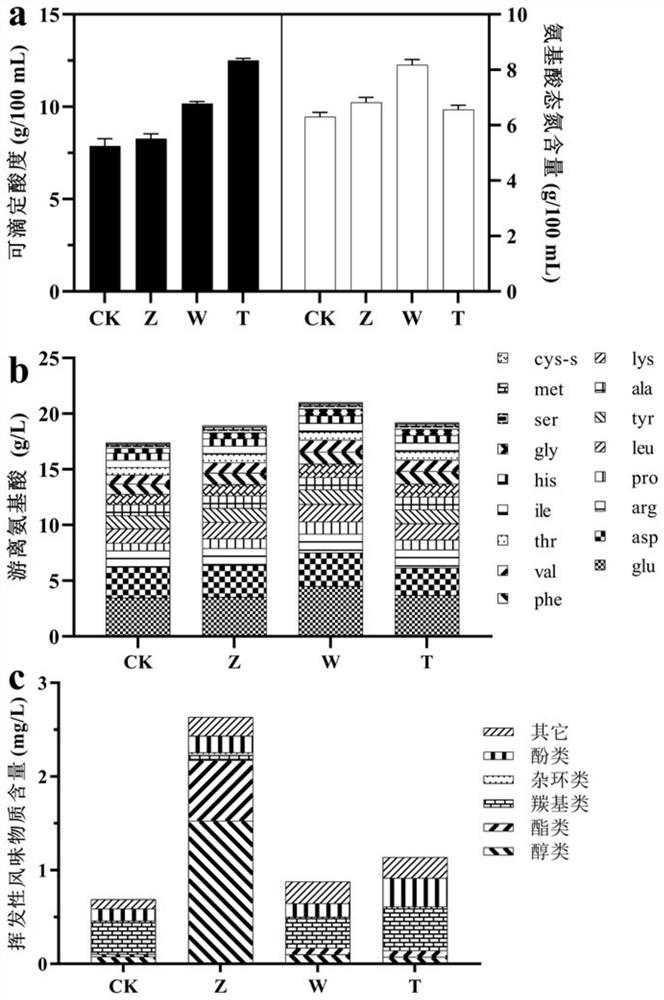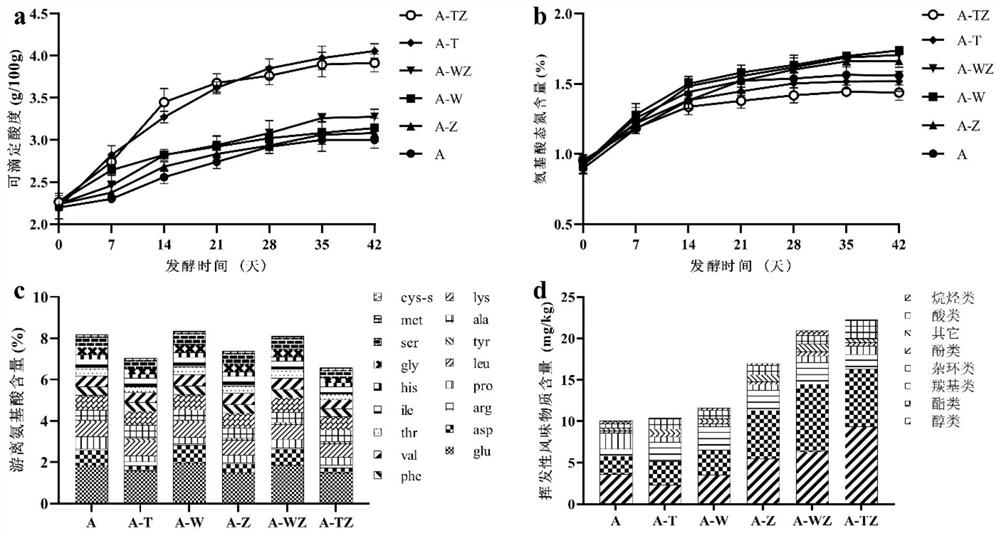Method for cooperatively fermenting thick broad-bean sauce by lactobacillus and zygosaccharomyces rouxii
A technology of combining yeast and synergistic fermentation of Lu's, applied in food science and other directions, can solve the problems of small effect and lack of understanding of co-fermentation, and achieve the effect of reducing sourness, improving quality and taste.
- Summary
- Abstract
- Description
- Claims
- Application Information
AI Technical Summary
Problems solved by technology
Method used
Image
Examples
Embodiment 1
[0035] Embodiment 1: the cultivation of bacterial strain
[0036] Inoculate Aspergillus oryzae on PDA slant medium, and culture it statically at 28°C for 2-3 days.
[0037]Zygomyces rouckeri was inoculated in YPD liquid medium at an inoculum size of 1 mL / 100 mL, and cultured at 30° C. with shaking at 200 rpm until mid-to-late logarithmic growth.
[0038] Inoculate the fused Lactobacillus weissnerii in the MRS liquid medium at an inoculum size of 1 mL / 100 mL, and culture it statically at 35° C. until the middle and late logarithmic growth.
[0039] The halophilic Tetradendococcus was inoculated in the MRS liquid medium containing 8 mL / 100 mL NaCl at an inoculum amount of 1 mL / 100 mL, and cultured statically at 30 ° C until the middle and late logarithmic growth.
Embodiment 2
[0040] Example 2: Environmental Tolerance of Bacterial Strains
[0041] (1) Growth of strains under different salt concentrations and pH
[0042] Zygomyces rouckeri, Tetrane halophilus and Lactobacillus weisserii were inoculated at different salt concentrations (0, 4, 8, 12, 16%) and pH (4.5, 5.0, 5.5, 6.0, 6.5, 7.0) culture medium at 30°C for 3 days, the culture solution was diluted and spread on YPD or MRS plate, and after 30°C culture for 3 days, the number of CFU viable bacteria of each strain was counted, and the number of each strain was determined. Growth status under different conditions.
[0043] Such as figure 1 It was shown that Lactobacillus weisserii can effectively grow under the salinity condition of 0-8% (g / 100mL), and Zygomyces rouckeri can grow under the salinity condition of 0-12%. But Tetradococcus halophilus could grow better only when the salinity was greater than 4%, and high salinity had no significant effect on its growth.
[0044] In addition, Lac...
Embodiment 3
[0048] Embodiment 3: the production performance of bacterial strain to flavor and nutrient substance
[0049] Using in vitro mixed culture fermentation method:
[0050] Add 10g of broad bean flour, 2.5g of wheat flour, 50g of fresh soy sauce unstrained spirits and 80g of sodium chloride into 1.0L of deionized water and boil for 30 minutes, filter and take the supernatant, divide the supernatant into triangular flasks and sterilize at 115°C Simulated liquid medium. Then, Zygomyces rouckeri, Lactobacillus weisserii, and Tetradococcus halophilus were respectively inoculated into the liquid medium to simulate the fermentation process of bean paste, and the initial cell density of each strain was set to 1×10 6 CFU / g. It was carried out at 30°C for 3 days. After the fermentation, the flavor substances of the single-bacteria fermentation liquid were detected, and the uninoculated fermentation medium was used as the reference substance. All experiments were performed in triplicate....
PUM
 Login to View More
Login to View More Abstract
Description
Claims
Application Information
 Login to View More
Login to View More - R&D
- Intellectual Property
- Life Sciences
- Materials
- Tech Scout
- Unparalleled Data Quality
- Higher Quality Content
- 60% Fewer Hallucinations
Browse by: Latest US Patents, China's latest patents, Technical Efficacy Thesaurus, Application Domain, Technology Topic, Popular Technical Reports.
© 2025 PatSnap. All rights reserved.Legal|Privacy policy|Modern Slavery Act Transparency Statement|Sitemap|About US| Contact US: help@patsnap.com



